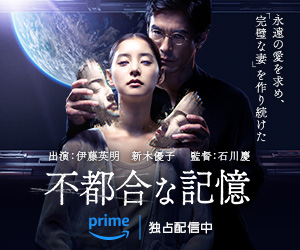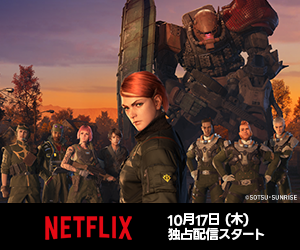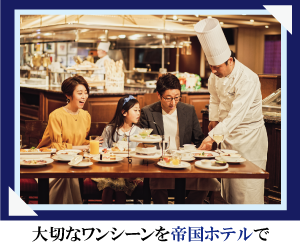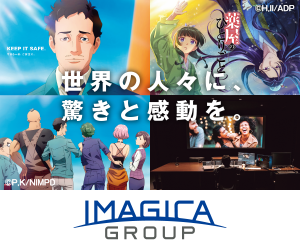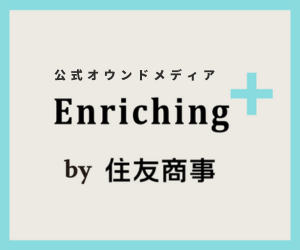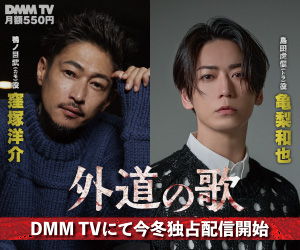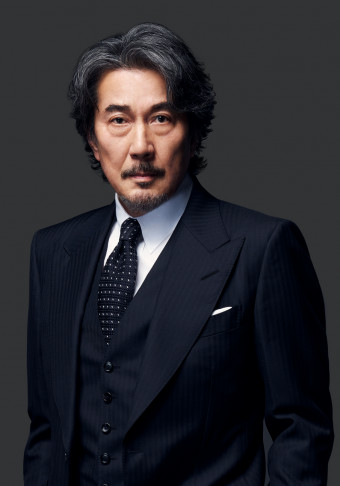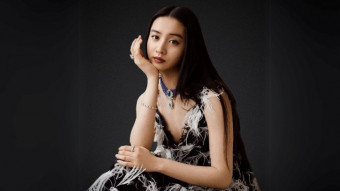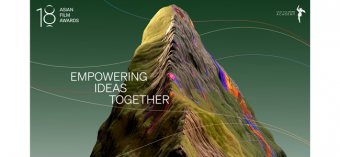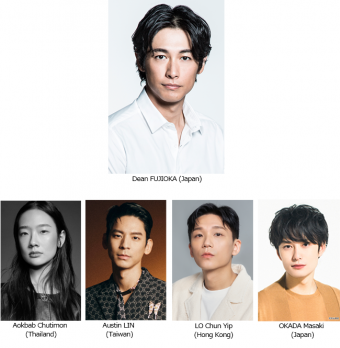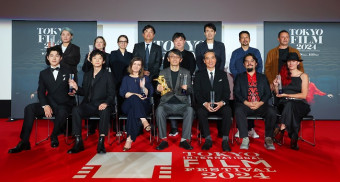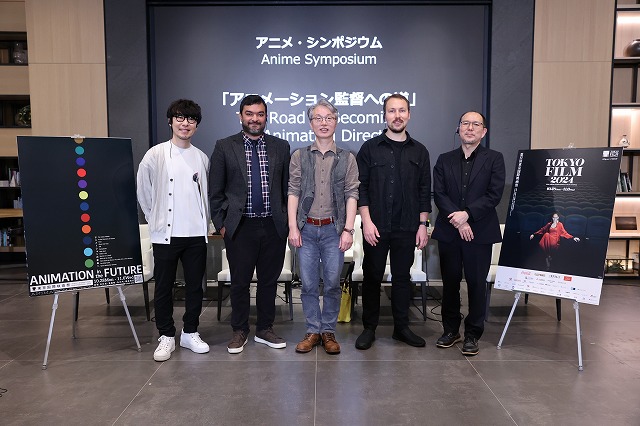
Directors Gints Zilbalodis (Flow), Ahn Jae-huun (Gill), Tomás Pichardo-Espaillat (Olivia & the Clouds), and Yoshiura Yasuhiro (Sing a Bit of Harmony) sat down with Animation Programming Advisor Fujitsu Ryota to discuss their careers, perspectives, and joys at the Road to Becoming an Animation Director symposium held on November 4 at the 37th Tokyo International Film Festival.
The four men had very different paths to becoming animation directors. Zilbalodis grew up in Latvia and said he always wanted to make films. However, he felt restricted with live action and animation gave him more freedom. Ahn grew up in a small, rural area of South Korea and spent a lot of time in nature and reading novels. He got into movies and music when he moved to the city and was attracted to animation because of the variety of genres and themes. Pichardo-Espaillat originally wanted to direct live-action feature films, but growing up in the Dominican Republic, found it difficult to access film — let alone animation — in school. He went to art school and made short films on the side, and the combination of his experimentation eventually merged into his style of animation. Yoshiura was always drawn to telling stories and got into animation in college, when digital tools allowed him to create animation independently.
The three non-Japanese directors were drawn to animation for another salient reason: the medium fit their personalities. Ahn said he liked the fact that he could work on specific tasks for a sustained period, while Pichardo-Espaillat said his shy personality prevented him from being able to approach actors, so animation allowed him to create despite that. Zilbalodis also preferred the small-team approach of animation: “I like to be alone with my thoughts and don’t want 100 people telling me what to do.”
Olivia & the Clouds is Pichardo-Espaillat’s first feature-length film, and Flow is Zilbalodis’s second. Both directors worked with larger teams than they had been accustomed to working with on their short films in the past. For Zilbalodis, this experience was quite stressful, as he could no longer work at his own pace and had to constantly answer staff’s questions about multiple scenes simultaneously. While the staff was relatively large, most of them still had to multi-task and were doing so much at all times of the day that “it felt like making a student production in college,” he said.
What helped him maintain control was his continued use of “animatics” — a rough edit of the storyboard — to discover ideas and impart them accurately to the staff. Through the process, he said that he was able to continue to create a personal vision, but while still utilizing the technical abilities of “much better animators than me.” Zilbalodis explained that the process is free-flowing; sometimes he starts with a shot that is supposed to be five seconds, but then keeps “adding and adding” and the shot ends up at five minutes. He might end up cutting the shot down, but the process allows him to be “very creative and spontaneous,” approximating the feeling of discovery in live action.
Pichardo-Espaillat said the Dominican Republic doesn’t have an animation tradition or culture, so he trained students in animation at a film school, with some of them becoming part of his team. They all came from different backgrounds, with their own styles of drawing, and rather than standardize their drawings into a uniform look, Pichardo-Espaillat used their diversity to his advantage, creating a film that “shows different points of view and different characters who interpret the same events.”
Olivia & the Clouds took many years to make, and as different voices were added (and as Pichardo-Espaillat himself grew) the story also changed to incorporate these new voices and perspectives. “Animators are like actors, like performers,” he argued, and it was his job as the director to interpret their actions and feelings. Pichardo-Espaillat said he was particularly drawn to this form of collaboration, where the entire staff is trying to put animated form to their ideas.
Yoshiura and Ahn have made several feature animated films in Japan and South Korea. As directors experienced working with large teams, both said that a director was the organizing force for any production and needed a clear vision. Ahn said he tries to maintain constant lines of communication with staff; even if they propose an idea that is rejected, he writes them a note of feedback about the idea. Yoshiura said that he also asks staff for ideas throughout production but maintains that a director must constantly remember the central concept of the film to ensure it doesn’t stray too far away from its foundation.
In discussing their influences, Zilbalodis said he was inspired by a wide range of cinematic luminaries, from Stanley Kubrick and Kurosawa Akira to Sergio Leone and Steven Spielberg. He singled out Alfonso Cuarón, however, for the director’s unique approach to the long take, where there are “multiple layers where many things are happening in the frame so the audience can choose where to look.” Watching it several times allows for the audience to notice details and think about the world of the film. In the process, he says, “The camera becomes like another character, influenced by other elements in the scene.”
Pichardo-Espaillat also cited a wide array of influences, from the romance of Ingmar Bergman and Wong Kar-wai to the experimental animation and music of Yuasa Masaaki and Philip Glass, and even the German expressionist artists in painting and film. He also singled out Cristóbal León & Joaquín Cociña’s The Wolf House and Tim Burton’s Beetlejuice for their unique approaches to stop-motion animation, showing him “how to play with textures” and making him aware “that people, that someone, created this.”
Ahn and Yoshiura said they also were inspired by many films and animations but were also influenced by less mediated works. Ahn became aware of emotions through poetry, where he was able to express his feelings of an unrequited love. Yoshiura, on the other hand, said his main inspiration is the work of Isaac Asimov, as the two share a desire to “make something unusual out of the familiar.”
When asked what is most important for an animation director, the panel said that the desire to create or impress something upon the audience was necessary. Pichardo-Espaillat explained that the way he sees the world is connected to the way he works: “My sister jokes that I’m married to animation because I’m always thinking about the world in terms of animation,” he laughed.
All four directors are currently working on projects that build off of their existing works: Zilbalodis and Pichardo-Espaillat are seeking new challenges — working with “actors and dialogue” or “hand-crafted materials” — while Ahn said he wants to make a film that tackles South Korea’s social issues such as “constant construction of new apartments despite the declining population.” Yoshiura said he wants to make a film that “transports the audience away” but also feels like it’s “their story.”
All four directors also agreed that the global animation boom is welcome. For Zilbalodis and Pichardo-Espaillat in particular, coming from countries with small animation industries or cultures, the ability to forge a mode of animation and express cultural traditions distinct from the dominant commercial animation industries around the world today is “incredibly exciting.”
Ahn neatly encapsulated the thoughts of the panel and audience: “I’m looking forward to a variety of animated works from a variety of countries.”
Anime Symposium
The Road to Becoming an Animation Director
Guests: Gints Zilbalodis (Director), Ahn Jae-huun [안재훈] (Director), Tomás Pichardo-Espaillat (Director), Yoshiura Yasuhiro (Director)














